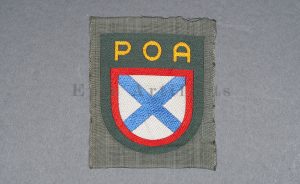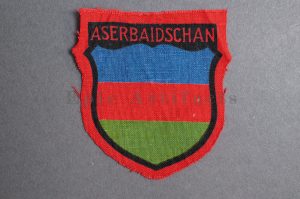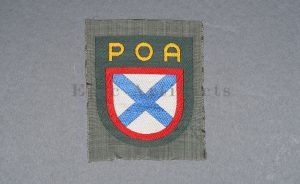Condition: Excellent
Sold
Product Description: This is a very desirable, early Panzer shoulder board, that was worn on the black Panzer wrap of a senior NCO in Panzer-Regiment 35. This unit, part of the 4. Panzer-Division, fought in the early campaigns in Poland and Kursk, and then on the Eastern Front from 1941-45, including at Orel, at Kursk, and in Kurland. This is a sew in type board as was commonly used on early wraps. It is textbook early construction throughout, including bright aluminum NCO Tresse and wool pipling in the pink branch color for Panzer. The zinc “35” cyphers retain traces of the original silvering. There is one aluminum pip, indicating the rank of Feldwebel; there is a trace of an additional pip which is now gone. An early Panzer shoulder board like this is not easy to find, and the unit ID to this piece adds to the appeal. Choice example.
Historical Description: The first German tank, called a “Panzer” (for “armor”), appeared in 1918. In the interwar years, German military strategists discussed how this new weapon should be employed on future battlefields. The first Panzer Divisions were formed in 1935. The German approach to tanks was generally different from the concepts of other militaries. In the Wehrmacht, Panzers would lead operations. They would be able to conduct operations independently from other units. This innovative approach was a crucial part of the German “Blitzkrieg” strategy, that yielded great German victories in the early years of World War II. The Wehrmacht attempted to achieve further successes with Panzers by constantly introducing new and better tanks with greater destructive capabilities, or other armored fighting vehicles suited for more specialized roles. Eventually, the German Army would field nearly 50 Panzer Divisions; the Waffen-SS had an additional 7 Panzer divisions, and even the Luftwaffe had a Panzer division of their own. These were elite units, often engaged in constant combat on all fronts. Panzer crews wore distinctive black uniforms with deaths-head collar patches, and matching black field caps. Many Panzer commanders in the Heer and SS were highly successful in combat, and some even became well-known personalities in wartime Germany. Surviving material related to Panzer troops is extremely sought-after and collectible today.
We are the leading team of military antique specialists. We have specialized in military antiques for over 25 years.
Epic Artifacts offers free evaluations and the highest prices available for your collectibles.
We purchase single items, entire collections, or family estates.
Click the link here to learn more: Free Evaluation or Inquiries
or feel free to email us directly: info@epicartifacts.com

In stock

In stock

In stock

In stock